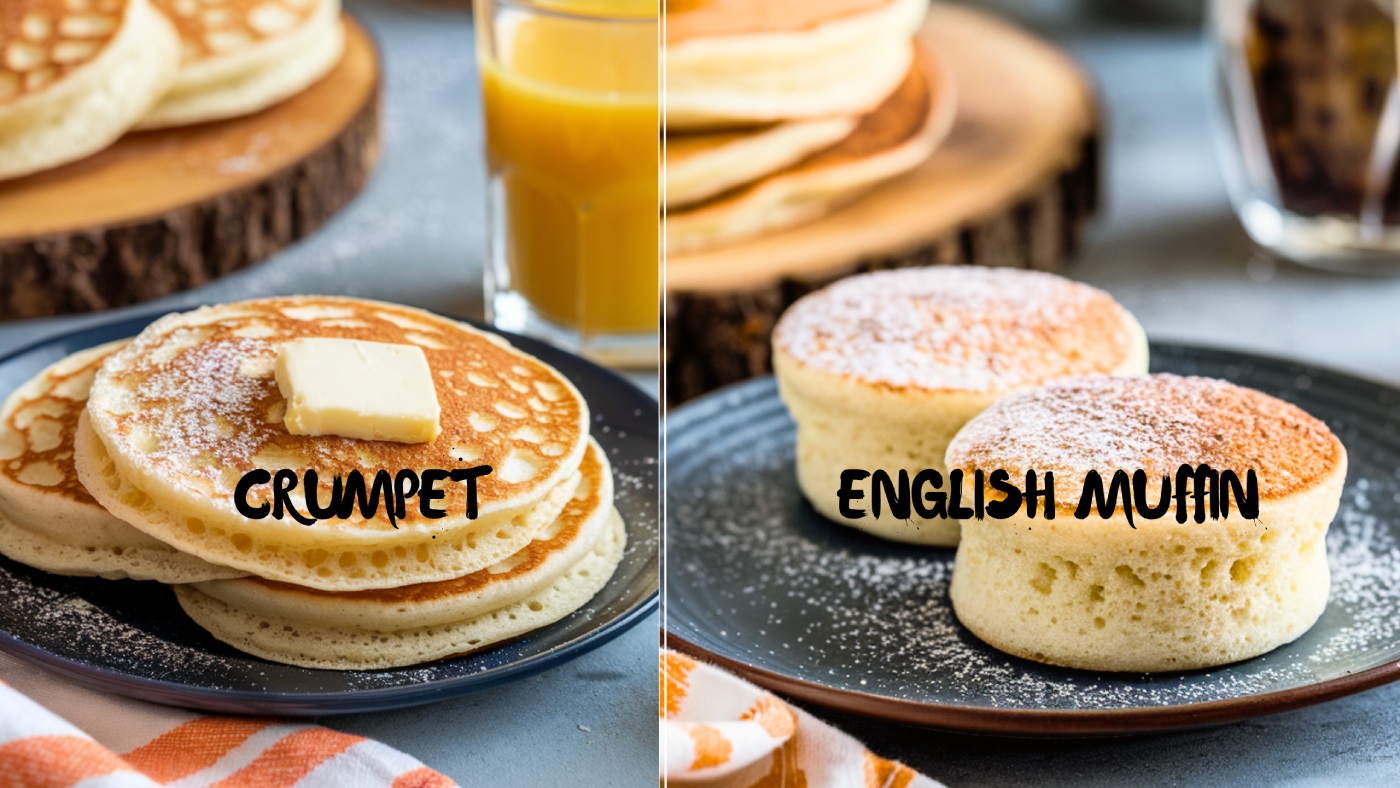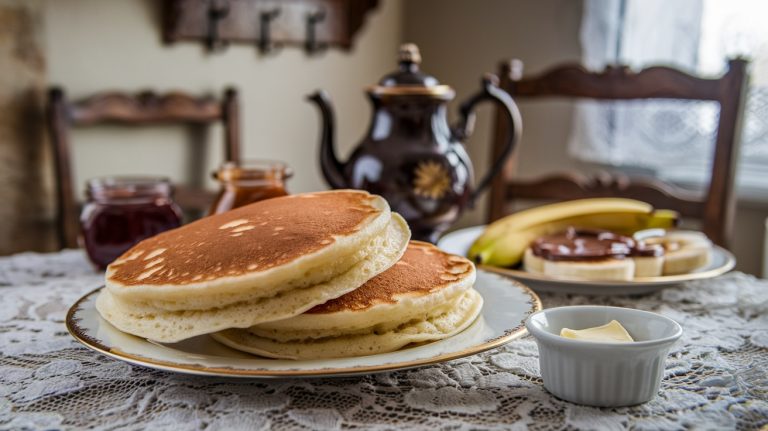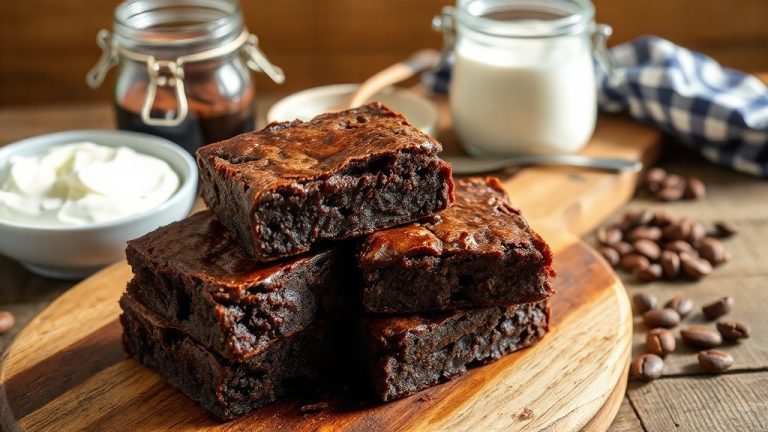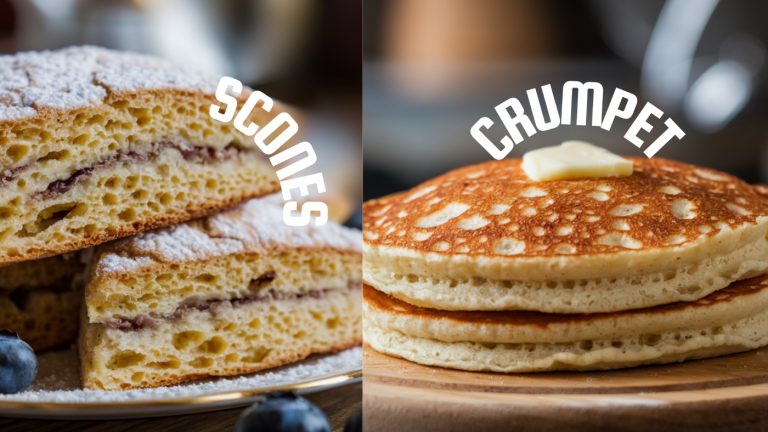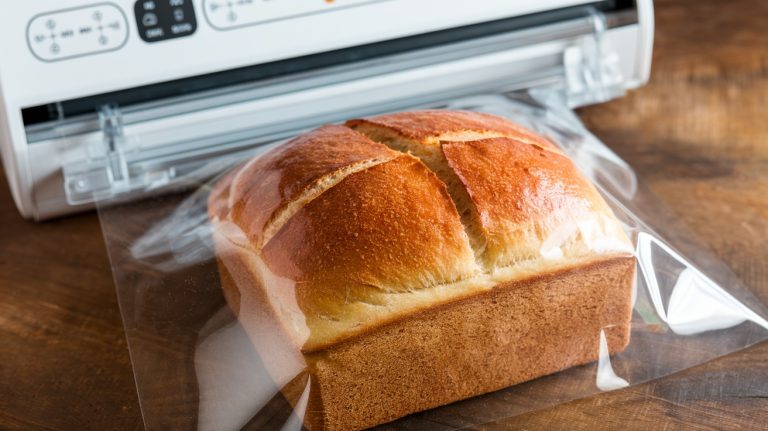Is a Crumpet the Same as an English Muffin?
A crumpet isn’t the same as an English muffin; they’re quite different. Crumpets are soft, round, and spongy with a distinctive honeycomb texture, often served with sweet or savory toppings.
They’re a British staple, deeply rooted in tradition. English muffins, on the other hand, are thicker, denser, and have a firmer bite, making them perfect for breakfast sandwiches. They originated from an American inspiration of crumpets.
While both share similarities, each brings unique flavors and textures to the table. If you’re curious about how to enjoy them or their fascinating histories, there’s much more to discover.
Key Takeaways
- Crumpets are soft, round bread with holes, while English muffins are thicker, flat, and yeast-leavened breads without holes.
- Crumpets originated in the UK, whereas English muffins were invented in America in 1894 by Samuel Bath Thomas.
- Crumpets have a spongy texture with a honeycomb interior, while English muffins are denser with a firmer bite.
- Crumpets are typically served whole with toppings, while English muffins are split before toasting and often used for breakfast sandwiches.
- Both are approximately three inches across but have distinct appearances, with crumpets being thinner and featuring delicate holes.
Definition and Origin
When you think of breakfast delights, crumpets and English muffins often come to mind, each boasting unique characteristics and origins.
Crumpets are round, soft, unsweetened breads with distinctive holes on top, cooked in crumpet rings. They offer a delightful, toasted texture that makes them perfect for slathering with butter. Crumpets are defined as a small, round, flat bread originating in the United Kingdom, traditionally made using flour, water, and yeast.
In contrast, English muffins are small, flat, yeast-leavened breads, toasted all around and often cut horizontally for easy topping.
While crumpets trace their roots back to Wales or Anglo-Saxon traditions, English muffins were invented in America by Samuel Bath Thomas in 1894, inspired by crumpets.
Each has evolved over centuries, but their cultural significance remains strong in their respective culinary traditions.
Key Ingredients
When you whip up crumpets and English muffins, you’ll notice some key differences in their dough compositions.
The hydration levels play a significant role in their textures, influencing how each one rises and bakes. Additionally, crumpets typically have a higher hydration level compared to English muffins, resulting in their signature holey tops and chewy insides.
Plus, the leavening agents used vary, affecting not just the flavor but also the overall experience of enjoying these delicious treats.
Dough Composition Differences
Although crumpets and English muffins may seem similar at first glance, their dough compositions reveal significant differences in key ingredients.
Crumpets rely on all-purpose flour, often combined with plain and bread flour, while English muffins use a mix of all-purpose and whole wheat flour. When it comes to leavening agents, crumpets require less yeast—just a teaspoon compared to the two teaspoons in English muffins. Sugar content is another contrast; crumpets typically have only a teaspoon, while English muffins contain a tablespoon.
Additionally, crumpets usually incorporate milk or water as their liquid base, whereas English muffins combine milk, melted butter, and egg. These differences shape the unique textures and flavors of each delightful baked good. The crumpet cooking method involves using non-stick baking rings for optimal shape and texture.
Hydration Levels Explained
Understanding hydration levels is essential for mastering the art of crumpet-making, as they directly influence the final texture and structure of the baked goods.
Crumpet batter typically boasts a hydration range of 90-100%, which is vital for developing those delightful bubbles and holes. In contrast, English muffins only reach about 50-57% hydration. Cooking crumpets at a lower temperature for a longer time can also help achieve the desired texture and structure. If you’re feeling adventurous, some recipes even push hydration to 130% or 160%, resulting in an incredibly soft and spongy texture.
Remember, the type of flour and whether you use water or milk will also impact hydration.
Leavening Agents Utilized
To create the perfect crumpet or English muffin, knowing the right leavening agents is key. Both rely on active dry yeast as their primary leavening agent, but crumpets often incorporate additional agents like baking soda and baking powder for extra lift. This evolution was significantly influenced by the 19th-century invention of baking powder, which transformed crumpet making and allowed for a lighter texture.
If you’re experimenting with sourdough, a sourdough starter can add unique flavors and textures to crumpets, a twist you won’t find in traditional English muffins. Typically, you’ll use about 1 to 2 teaspoons of yeast in crumpets and slightly more—around 2 teaspoons—in English muffins.
The way these leavening agents work together not only enhances the rise but also contributes to their distinctive flavors, making your baking experience both delightful and rewarding.
Texture Differences
When you take a bite of a crumpet, you’re greeted by a slightly rubbery yet chewy texture, distinctly different from the firmer bite of an English muffin. Crumpets are light and spongy, with a unique bubble structure that allows them to absorb toppings beautifully. This characteristic is due to the bicarbonate of soda used in the batter, which aids in creating those signature bubbles.
Before toasting, they feel soft, while their open texture traps butter and jam in those delightful holes. In contrast, English muffins offer a thicker, denser experience, often rolled in cornmeal, which gives them a grainy touch. Their firmer texture makes them perfect for breakfast sandwiches, providing a sturdier base.
These texture differences not only define each treat but also shape how you enjoy them, enhancing your culinary experience.
Appearance Comparison
Although both crumpets and English muffins share a round shape and similar diameter, their appearances set them apart in delightful ways.
Crumpets are thinner, featuring delicate round holes on top and a spongy texture on one side, giving them a unique look. When homemade, they boast a golden hue, while store-bought versions may appear lighter. This characteristic bubble holes are essential for butter absorbency, enhancing their appeal.
In contrast, English muffins are thicker with a solid top, revealing holes only after you split them open. Often sprinkled with cornmeal or semolina flour, their exterior adds texture.
Both are about three inches across, but the firm, solid surface of English muffins contrasts sharply with the crumpet’s soft, airy charm, making each a visual treat in its own right.
Serving Suggestions
When it comes to serving crumpets and English muffins, the options are as delightful as the breads themselves.
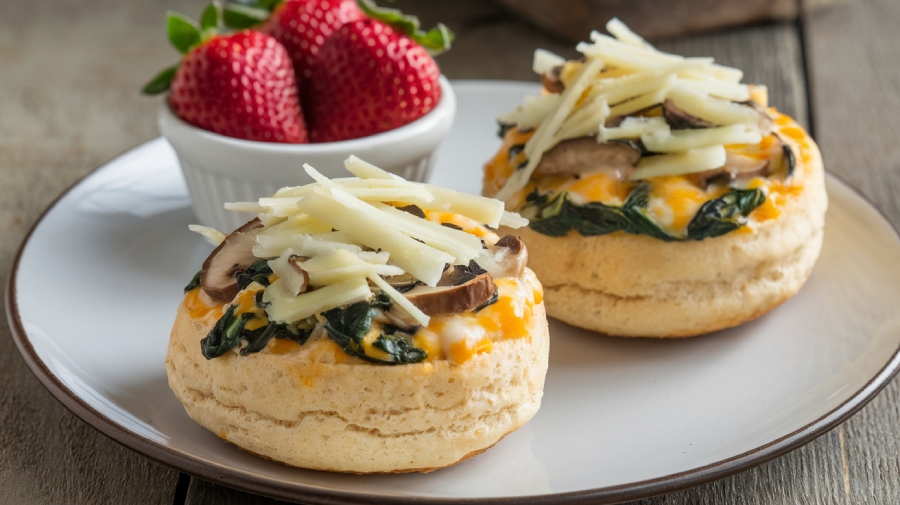
You can load crumpets with sweet toppings like honey or savory delights like spiced shrimp, while English muffins shine in breakfast sandwiches or as mini pizzas. Crumpets can also be topped with a creamy mixture of soft cheese and harissa, adding an exciting flavor twist. Each has its own unique charm, offering endless possibilities for your next meal.
Traditional Toppings for Crumpets
Crumpets are a delightful canvas for an array of toppings, offering endless possibilities that cater to both sweet and savory cravings. Whether you prefer a rich, indulgent treat or a wholesome breakfast, there’s a crumpet topping for you. Notably, crumpets can be transformed into delicious crumpet sandwiches when layered with cheese and meats.
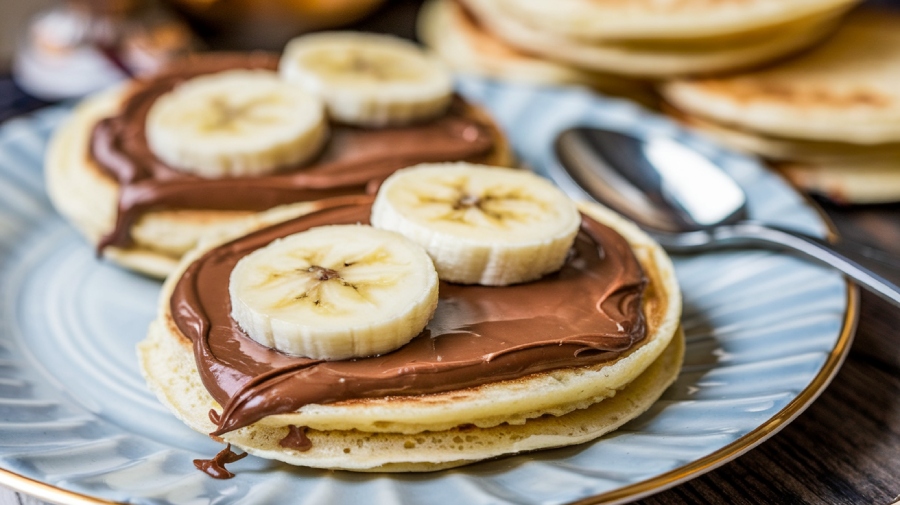
Here’s a quick guide to inspire your next crumpet creation:
| Sweet Toppings | Savory Toppings | Gourmet Toppings |
|---|---|---|
| Peanut Butter and Jelly | Cheese | Pesto and Grilled Halloumi |
| Nutella and Sliced Bananas | Avocado and Poached Egg | Goat’s Cheese and Beetroot |
| Lemon Curd and Powdered Sugar | Smoked Salmon and Cream Cheese | Dark Chocolate and Sea Salt |
Popular English Muffin Uses
Whether you’re craving a hearty breakfast or a creative snack, English muffins offer a versatile foundation that can elevate any meal.
Start your day with toasted muffins topped with butter and jam or whip up a satisfying breakfast sandwich loaded with eggs, cheese, and crispy bacon. For a fresh twist, try avocado toast on a toasted muffin, seasoned with lemon juice and pepper. The unique texture of English muffins makes them perfect for holding toppings without becoming soggy.
For lunch, indulge in a tuna melt or a grilled cheese sandwich, both bursting with flavor.
Don’t forget dessert! Toasted muffins can transform into delightful treats with chocolate chips, marshmallows, or cinnamon sugar. You can even use them for mini pizzas or savory appetizers, showcasing their incredible adaptability in your kitchen.
Serving Styles Comparison
While both crumpets and English muffins serve as delightful bases for a variety of toppings, their serving styles and cultural contexts create distinct dining experiences. Crumpets are toasted whole, soaking up sweet or savory toppings like butter and jam, often enjoyed during tea time.
In contrast, English muffins are split and toasted, forming a sturdy base for breakfast sandwiches or spreads like peanut butter.
| Crumpets | English Muffins |
|---|---|
| Toasted whole | Split before toasting |
| Absorb toppings well | Thicker, crispy texture |
| Traditionally served with tea | Part of an American breakfast |
Both offer versatility, yet their textures and cultural significance set them apart, making each a unique treat.
Cultural Importance
Though often confused with English muffins, crumpets hold a unique place in British culture that dates back to the 17th century. These fluffy delights are essential during tea time and breakfast, typically enjoyed with jam and clotted cream. Crumpets embody a sense of comfort, deeply rooted in British culinary tradition, distinctly separate from their American counterparts.
Cultural contexts enhance the appreciation of crumpets, as they symbolize a cherished tradition that resonates across generations. Across the UK, regional variations like pikelets showcase local adaptations, highlighting their versatility. Unlike English muffins, crumpets are made from batter, not dough, solidifying their unique identity. Their presence in British literature and media further cements their cultural significance, making them a beloved symbol of tradition and warmth, transcending class boundaries and inviting everyone to savor their deliciousness.
Preparation Methods
Crumpets and English muffins, while both beloved breakfast staples, differ considerably in their preparation methods, underscoring their unique identities.
To make crumpets, you combine heated milk with sugar and yeast, letting it froth before mixing in flour, salt, and baking powder. After resting the batter in a warm spot, pour it into greased rings on a skillet, cooking until bubbles rise and the tops dry. This process results in a light, honeycomb-like interior that is characteristic of crumpets.
In contrast, English muffins start with a thick dough made from warm milk, yeast, sugar, and melted butter, plus an egg. After rising, you shape them and cook both sides on a griddle, often sprinkling cornmeal to prevent sticking.
Flavor Profiles
How do crumpets and English muffins differ in flavor? While both are beloved breakfast treats, their flavor profiles set them apart.
- Crumpets are softer, milder, and spongy, with a yeasty taste.
- English muffins carry a unique sourdough flavor and are denser.
- Crumpets’ porous texture makes them perfect for soaking up butter and jam.
When you bite into a crumpet, you’ll experience a tender inside and a mildly crispy exterior, unlike the firmer texture of English muffins. Additionally, crumpets are made with yeast and flour, contributing to their light and airy structure.
Common Misconceptions
What misconceptions might you have about crumpets and English muffins? While they may seem similar, they’re quite different. Understanding these distinctions can enhance your appreciation for each.
| Aspect | Crumpets vs. English Muffins |
|---|---|
| Origin | Crumpets: 17th century Britain; Muffins: NYC, 1894 |
| Texture | Crumpets: Thinner, chewy holes; Muffins: Thicker, solid tops |
| Preparation | Crumpets: Cooked on one side, served whole; Muffins: Cooked both sides, sliced |
| Popularity | Crumpets: UK and former territories; Muffins: American breakfast staple |
| Serving Style | Crumpets: Tea time snack; Muffins: Breakfast sandwiches |
Recipe Overview
When you’re ready to elevate your breakfast or tea time, exploring the recipes for crumpets and English muffins can be a delightful journey.
Both offer unique textures and flavors that can transform your meal. Here’s what you can expect:
- Crumpets: Light, chewy, and dotted with holes, perfect for spreading butter or jam. The batter rest time is crucial for developing those characteristic bubbles.
- English Muffins: Thicker, denser, and ideal for toasting or making breakfast sandwiches.
- Cooking Method: Both are cooked on a skillet, but crumpets are only flipped once.
For crumpets, you’ll combine warm water, yeast, and flour, letting it rise before cooking. Crumpets are yeast-leavened cakes that feature a spongy texture with iconic holes, enhancing their ability to soak up toppings.
For English muffins, you’ll blend milk, yeast, and flour, allowing for a longer rise.
Frequently Asked Questions
Can Crumpets and English Muffins Be Used Interchangeably in Recipes?
While crumpets and English muffins share similarities, they aren’t always interchangeable in recipes.
Crumpets, with their chewy texture and delicate holes, shine when topped with butter or jam, creating a delightful breakfast experience.
English muffins, thicker and firmer, work well for sandwiches or mini pizzas.
If you’re craving a quick meal, you can switch them up, but be mindful of the texture and flavor differences that enhance your dish.
Are Crumpets Gluten-Free or Suitable for Celiac Diets?
If you’re considering crumpets for a gluten-free diet, you’ll be pleased to know that they can be made without gluten-containing ingredients.
Brands like Warburtons offer gluten-free crumpets using rice flour and maize starch.
Just remember, if you’re making them at home, traditional recipes include gluten, so you’ll need to substitute with gluten-free flours.
Always check the labels, as some crumpets may contain ingredients like egg, which could pose an allergy risk.
What Are the Best Toppings for Crumpets and English Muffins?
Imagine a canvas, warm and inviting, just waiting for your creative touch.
For crumpets, you can layer soft cheese with honey and spicy harissa, or indulge in a savory smoked salmon delight.
English muffins beckon for classic butter and jam, or a hearty breakfast sandwich featuring eggs and bacon.
Both hold endless possibilities; whether drizzled or piled high, each bite transports you to brunch bliss.
Let your taste buds lead the way!
How Do Crumpets and English Muffins Differ in Nutritional Value?
Crumpets and English muffins differ considerably in nutritional value.
Crumpets pack about 86-90 calories and are lower in carbs and protein compared to English muffins, which typically have around 120-150 calories.
While crumpets are spongy with minimal fat, English muffins offer a denser texture and slightly higher fat content.
If you’re counting calories or carbs, crumpets might be your go-to, but English muffins provide a heartier bite for breakfast sandwiches.
Can You Freeze Crumpets and English Muffins for Later Use?
Yes, you can freeze both crumpets and English muffins for later use.
To keep them fresh, wrap each crumpet in foil, place them in a sealed bag, and store them in the freezer for up to six months.
For English muffins, use airtight containers or bags.
When you’re ready to enjoy, toast them directly from the freezer, but avoid refreezing to maintain their delightful texture.
Enjoy your tasty treats anytime!
Why Not Both to Start Your Day?
To sum up, while crumpets and English muffins may seem similar, they each offer unique textures and flavors that cater to different tastes. Did you know that over 50 million crumpets are made every year in the UK alone?
Whether you’re enjoying the chewy, holey delight of a crumpet topped with butter or the toasted, hearty goodness of an English muffin with your favorite spread, both are sure to elevate your breakfast experience. So, why not try them both?

